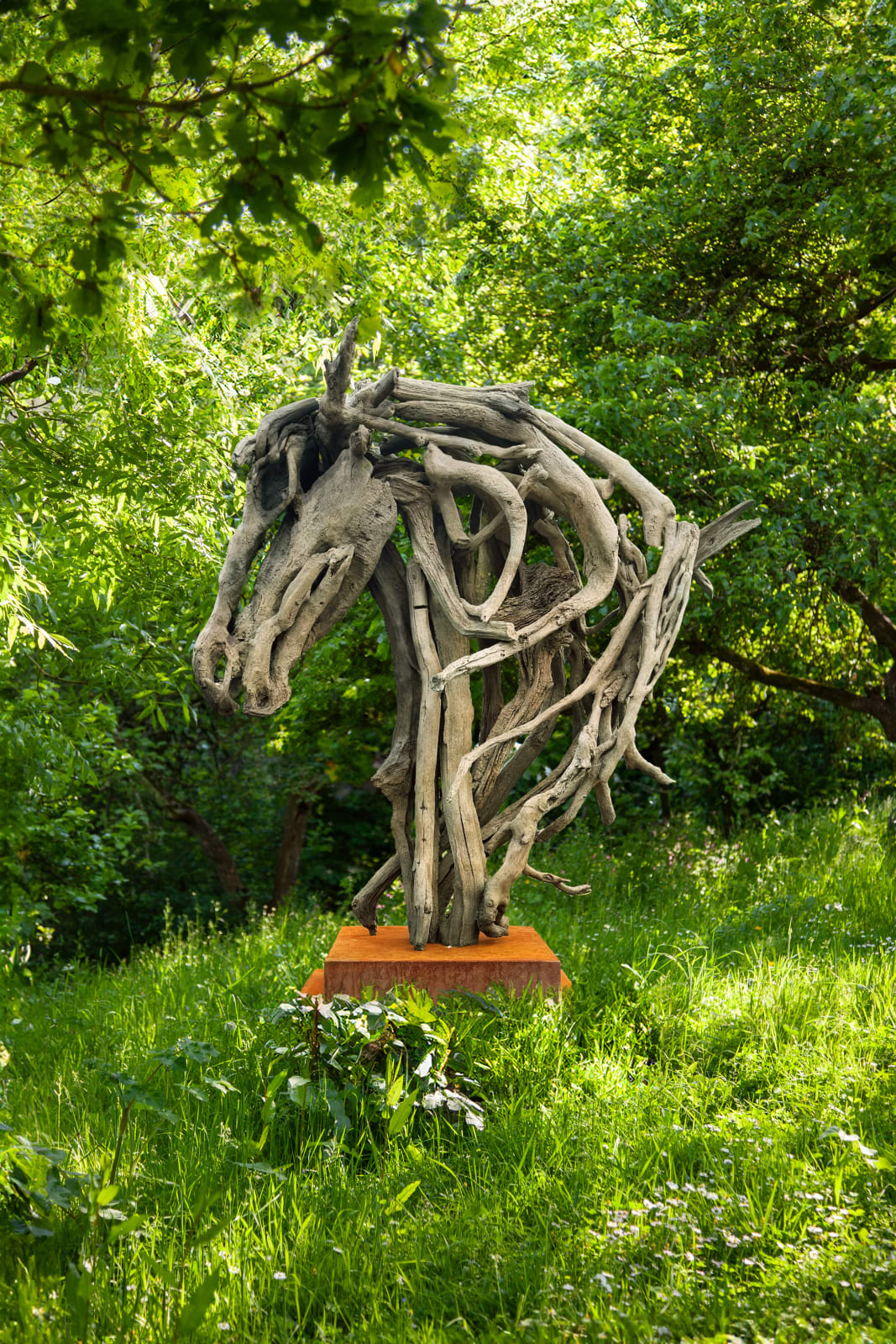Heather Jansch British, 1948-2021
Madrugada, 2014
Bronze
178 x 152 x 61 cm (270cm high inc base)
70 1/8 x 59 7/8 x 24 in
70 1/8 x 59 7/8 x 24 in
Edition 2 of 5
Further images
'Madrugada' meaning early morning or dawn is Heather Jansch's largest work from her horse head series. In this signature piece, Jansch has skillfully used the driftwood from which the original...
'Madrugada' meaning early morning or dawn is Heather Jansch's largest work from her horse head series. In this signature piece, Jansch has skillfully used the driftwood from which the original was made to highlight Madrugada's power and dynamism whilst taking care to give the interior of the structure texture with a particularly beautiful piece of aged and knarled wood. Cast beautifully in bronze this fabulous sculpture would charge any interior or exterior setting with energy.
Heather Jansch was born in Hockley, Essex and studied Fine Art at Goldsmiths, University of London. In 1968, she moved to a remote hill farm in Wales, where she bred Welsh Cobs. This period, which Jansch described as her apprenticeship, allowed her to develop a profound understanding of equine behaviour and anatomy. She also became adept at discerning the subtle differences between closely related breeds. Her keen eye and accuracy quickly gained the attention of breeders, and her early traditional equine portraits in oils became much sought after.
In 1981, Jansch settled in South Devon, where a new style began to emerge in her painting, characterised by vibrant colours and increasingly impressionistic canvases. Driven by a restless desire to push her artistic boundaries, she began experimenting with three-dimensional work, initially using copper wire and plaster. However, feeling frustrated by the lack of power and vitality in her early sculptures, she turned to driftwood, which was abundant on the beaches of Devon. Driftwood proved to be the key that unlocked her creativity, marking the beginning of an immensely successful and celebrated artistic output. Jansch pioneered the use of driftwood in sculpture, transforming discarded natural materials into powerful equine forms that speak to humanity’s deep-rooted connection with horses.
In 2007, Jansch was the artist in Residence at the Eden Project in Cornwall, where she created the iconic life-size driftwood horse known as the Eden Horse. Over the years, Jansch perfected the process of translating her intricate driftwood sculptures into bronze. She developed a pioneering casting technique that made the bronze pieces indistinguishable from the original driftwood and maintained the raw vitality of the wood whilst adding the permanence of the metal. She also expanded her practice to include a series of powerful horse heads, as well as sculptures of dancers and warrior women, created from a combination of wood, copper and found objects.
Jansch exhibited widely in the UK and internationally, with her work held in private collections across Europe, the USA, and Canada.
Heather Jansch was born in Hockley, Essex and studied Fine Art at Goldsmiths, University of London. In 1968, she moved to a remote hill farm in Wales, where she bred Welsh Cobs. This period, which Jansch described as her apprenticeship, allowed her to develop a profound understanding of equine behaviour and anatomy. She also became adept at discerning the subtle differences between closely related breeds. Her keen eye and accuracy quickly gained the attention of breeders, and her early traditional equine portraits in oils became much sought after.
In 1981, Jansch settled in South Devon, where a new style began to emerge in her painting, characterised by vibrant colours and increasingly impressionistic canvases. Driven by a restless desire to push her artistic boundaries, she began experimenting with three-dimensional work, initially using copper wire and plaster. However, feeling frustrated by the lack of power and vitality in her early sculptures, she turned to driftwood, which was abundant on the beaches of Devon. Driftwood proved to be the key that unlocked her creativity, marking the beginning of an immensely successful and celebrated artistic output. Jansch pioneered the use of driftwood in sculpture, transforming discarded natural materials into powerful equine forms that speak to humanity’s deep-rooted connection with horses.
In 2007, Jansch was the artist in Residence at the Eden Project in Cornwall, where she created the iconic life-size driftwood horse known as the Eden Horse. Over the years, Jansch perfected the process of translating her intricate driftwood sculptures into bronze. She developed a pioneering casting technique that made the bronze pieces indistinguishable from the original driftwood and maintained the raw vitality of the wood whilst adding the permanence of the metal. She also expanded her practice to include a series of powerful horse heads, as well as sculptures of dancers and warrior women, created from a combination of wood, copper and found objects.
Jansch exhibited widely in the UK and internationally, with her work held in private collections across Europe, the USA, and Canada.
Provenance
From the artist's estateJoin our mailing list
* denotes required fields
We will process the personal data you have supplied in accordance with our privacy policy (available on request). You can unsubscribe or change your preferences at any time by clicking the link in our emails.





